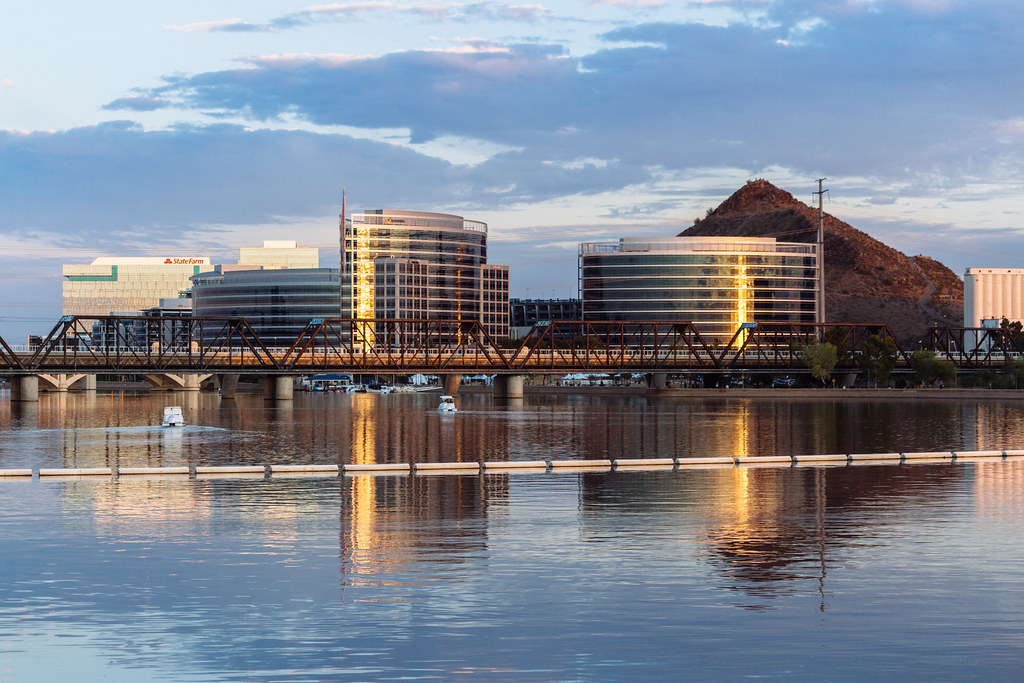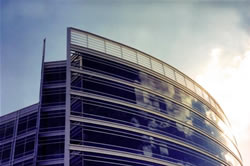2024 Tempe Visitors Guide
The heartbeat of Phoenix. Energetic, exciting, entertaining and convenient. That’s Tempe. A college town. A family place. Where everyone goes to have fun. In the days of the old west, Tempe was the ferry crossing to get to the other side of the Salt River. Today, Tempe is still the lively connection between Phoenix and the cities in the East Valley. Home to Arizona State University, the popular Mill Avenue District, Tempe Town Lake and over 40 hotels that promise a grand time to all that visit.
Located just minutes from Phoenix Sky Harbor International Airport and a main station stop of the Metro Light Rail Train that connects downtown Tempe with downtown Phoenix, Tempe AZ is the perfect home base for vacationers and those visiting the Valley of the Sun on business. The hub center Mill Avenue historic district is pedestrian-friendly. Here you can walk to the finest Tempe restaurants, enjoy active nightlife, go to the theater, go to a football game, stroll alongside the lake, visit a museum and attend one of over a hundred annual events and festivals.
Things to do in Tempe Arizona
Tempe is the definition of a city filled with cultural venues, art, and entertainment. Along with almost any cuisine imaginable, the city is full of offerings, many of the options found in much large, more populated economic centers. Among the long list of cultural venues, some include the Edna Vihel Activities Building, in the city’s Community Center complex, which opens its doors to participation in the arts to children and adults offering classes in the visual and performing arts.
The Tempe Historical Museum collects, preserves and exhibits aspects of Tempe’s history. The Tempe Symphony Orchestra presents four free annual concerts at Boyle Auditorium in McClintock High School. The orchestra, formed in 1973, is composed of approximately 80 musicians.
Arizona State University contributes to Tempe’s cultural scene with the famous Frank Lloyd Wright-designed Grady Gammage Memorial Auditorium.
Downtown Tempe can stand on its own as a cultural center, too. The Spring and Fall Festivals of the Arts draws nearly 250,000 people respectively. Visitors may take in art, food and free live entertainment. The events are held on the first weekend of December and March and are the second-largest juried art festivals in the nation.
Childsplay is a professional company of adult actors performs for young people. Founded in 1977, the group has performed for more than 750,000 children and adults throughout the Southwest and is housed in the Tempe Performing Arts Center in downtown Tempe.
Additionally, the award-winning parks and recreation department hosts more than 1,200 acres in 47 parks and facilities including two 18-hole golf courses. Baseball comes to town every February as the Los Angeles Angels practice and plays spring training games at Tempe Diablo Stadium. Tempe also is the home to college football’s annual Fiesta Bowl. Additionally, there’s biking, kayaking, canoeing, skating and picnicking.
Tempe Town Lake
Crown Jewel of Tempe. This two-mile long lake is in the heart of Tempe’s recreational and entertainment scene. The south shore banks of Tempe Town Lake hugs the edges of the historic downtown Mill Avenue District and Sun Devil Stadium on the campus of Arizona State University. Students, residents and visitors can spend the morning sailing across the lake, enjoy a jog along lakeside paths at lunch, shop the boutiques of Mill Avenue, have dinner at a nice restaurant and then take a romantic stroll along the still waters all in the same day.

Choose your pleasure
Boat, sail, canoe, kayak, fish, skate, jog, picnic, attend a concert, take the kids to Splash Park or just layout a blanket and enjoy some incredible sunsets. Bring your own boat (electric motor) or rent a paddle boat from Rio Lago Cruise Company on the north shore. The lake’s multi-use trail circles the lake beginning at Tempe Beach Park. The 3-mile route from Mill Avenue to Rural Road is the equivalent of a 5K race making it an ideal training run for area races and marathons.
Great urban fishing
The lake is frequently stocked with rainbow trout while largemouth bass and channel catfish are natural inhabitants of the lake. There have been many lunker bass caught at Tempe Town Lake. Fishing enthusiasts older than 13 years must have an Arizona fishing license and can be purchased at local sporting supply stores. For more fishing info, visit the Tempe Government Town Lake and Arizona Game and Fish websites.
Entertainment, concerts and festivals
There are several small amphitheaters at or around Tempe Town Lake that feature staged community entertainment and seasonal concerts. There are over 100 annual events scheduled in and around Tempe Town Lake every year including the July 4th Festival and Fire Works, the Holiday Boat Parade and the Tempe Music Festival.
The Tempe Center for the Arts is located at he southwestern end of the next to Tempe Beach Park. The Center of the Arts features a 3,500 square foot art gallery, an art park and an outdoors banquet and conference facility.
Tempe Beach Park
Tempe Beach Park is located at the west-end of Tempe Town Lake. Tempe Beach is the crown jewel of the Tempe Parks System and is the main venue for over 75 events every year including Tempe Music Festival, Tempe Oktoberfest, Festival of Holiday Lights Boat Parade, and the Tempe Fourth of July Fireworks Show. Tempe Beach, next to the Mill Avenue District.
The 25-acre park features 5 miles of jogging paths along the banks of Tempe Town Lake, ramadas and picnic areas. The Splash Play Ground at Tempe Beach Park is a one-acre, free playground that is centered on water recreation including water slides and sand play areas that are covered in only two inches of water. An attendant is always available during operating hours.
For more information about events, reserving picnic ramadas, and guidelines of use, contact Tempe Parks and Recreation.
Parks & Recreation Dept.
Administrative Office 3500 South. Rural Rd.
Tempe AZ 85282
(480) 350-5200
Mill Avenue District
A destination by itself. As home to Arizona State University, Tempe has all the lively energy your would expect from a college town. Particularly one with almost 60,000 students. Mill Avenue is the hub of activity. It’s the destination for the free- spirited in search for where it’s all happening. The atmosphere in and around Mill Avenue can be best described as “alive”.
Mill Avenue isn’t just for college kids.
It is a family-friendly kind of place that often gets blocked off to handle events and celebrations. This downtown district is uniquely pedestrian-friendly that captures an interactive crowd. With over 100 restaurants, a seemingly endless variety of nightlife spots, boutique shopping, and movie theatres combined with the adjacent Tempe Town Lake, Sun Devil Stadium and ASU Ganmmage Auditorium, people here will never run out of things to do.
Imagine red brick sidewalks.
All lined with shade trees, turn of the century architecture that is still in use, outdoor dining areas and street entertainment, Mill Avenue is a great place just to people-watch. Bike and stroll the paths around Tempe Town Lake. Kayak the waters. Enjoy the annual events like the Tempe Festival of the Arts, the Tempe Festival of Lights and the Insight Fiesta Bowl Block Party, one of the America’s most attended outdoor New Year’s Party.
Conveniently located.
The university and its dorms are within easy walking distance from Mill Avenue. High rise condos set next to the lake. And college football enthusiasts going to and leaving the game fill the streets. And with the Valley Metro Train, people can get from Tempe to Downtown Phoenix and places in between with relative ease making Mill Avenue and Tempe one of the most active hot spots in the Greater Phoenix area.
Tempe Dining
One thing you can count on. You will not go hungry in Tempe. Arguably, Tempe, Arizona has the largest concentration of restaurants in the Phoenix area. Walk up and down Mill Avenue. There are so many dining choices, you’ll have a difficult time choosing one. And there are so many more within close driving distance. Whether your temptations are the quaint, upscale, the informal, a bar and grill or outdoor patio dining, you’ll discover an ambiance that fits your style and a cuisine that satisfies your taste. From Mexican food, Asian delicacies, fine steakhouses, and delectable seafood to Italian flair, Pizza or just burgers, you will enjoy some of the best restaurants in Tempe AZ.
Tempe dining offers range from casual or elegant, even the most discerning palate will be pleased. Cuisines from around the world can be found here including Middle Eastern, Asian, Mexican and American. There are several microbreweries, sports bars and pubs, as well.
Tempe Demographics
- Tempe is in Maricopa County and has a population estimated at about 160,000 people.
- The median income for a household in the city is about $43,000, and the median income for a family was $55,000
- Men had a median income of $36,400 versus $28,600 for women.
Business and Economy
Tempe has the highest concentration of high technology firms in Arizona. In addition, it has the densest industrial area in Arizona and represents the highest concentration of businesses in Arizona. While Tempe represents less than four percent of the state’s population, more than 15 percent of Arizona’s high-tech companies are located in Tempe. The city is actually the 7th largest in the state. Tempe, though seemingly removed from the many other United States business centers, is actually the home to a thriving business community. In actuality, the city has a prime location near Phoenix, which contributes to it success in attracting and keeping companies here. Tempe also is home to more than 106 office complexes and developments.
 Arizona State University’s Research Park is an example of the type of developments found here. The park was established in 1984 to help build relationships between the university and industries and covers 323 acres with tenants primarily in research and development.
Arizona State University’s Research Park is an example of the type of developments found here. The park was established in 1984 to help build relationships between the university and industries and covers 323 acres with tenants primarily in research and development.
Major companies located in the Research Park include Motorola Labs and Edward Jones Brokerage. The Research Park boasts more than 18 acres of an environment of mature landscaping, three lakes, six miles of jogging paths and tennis courts. Tempe is the home to Honeywell, America West Airlines, Medtronic Microelectronics, America West Airlines, Motorola and Chase Manhattan Bank, among many others.
Tempe’s favorable tax structure and proactive approach to business development, combined with its prime location, create the ideal climate for businesses to grow and prosper. As a city, Tempe has started an initiative to foster business growth and encourage development that allows for creativity in the economy. The city has exploded in the past two decades, fostered by the development of high-tech industry, financial, insurance, tourism, and academic ventures.
History of Tempe
Tempe, Arizona, now a thriving city, had a humble beginning rooted in agriculture. Named after the rich valley on the banks of a wide river, settlers thought it reminded them of ancient Greece.
After the establishment of Fort McDowell on the eastern edge of central Arizona’s Salt River Valley in 1865, Tempe grew in popularity. Farmers moved into the area and dug irrigation canals to transport Salt River water to their fields, which were left by the prehistoric Hohokam people. Valley farms quickly supplied food to Arizona’s military bases and mining towns. Hispanics were the first settlers.
Some of these Mexican settlers established San Pablo, a town near Tempe Butte, another small colony nearby, in 1872. Within a few years, the settlement had stores and a flour mill, warehouses, blacksmith shops, and a ferry, and it quickly became the trade center for the Salt River Valley’s south side. Both settlements grew quickly and soon merged to form Tempe, which was named in 1879 after the river and the nearby expanse of green fields; Tempe was named after the Vale of Tempe in ancient Greece.
The city quickly became known for alfalfa and grains used to feed livestock, thanks to a network of canals that carried water to more than 20,000 acres of prime farmland. Wheat, barley, and oat crops ensured the emerging economy’s stability. The flour was transported to forts and other settlements across the territory. By the 1890s, some farmers had begun to grow new cash crops like dates and citrus fruits.
Tempe was chosen as the site for the Territorial Normal School, which trained teachers for Arizona’s schools, by the Arizona legislature in 1885. Other changes in Tempe aided the development of the small farming community, and in 1887, the Maricopa and Phoenix Railroad crossed the Salt River at Tempe, connecting the town to the rest of the country and bringing their cash crops with them. The city quickly rose to prominence as one of the region’s most important business and shipping hubs.
The completion of the Roosevelt Dam in 1911 ensured that there would be enough water to meet the growing needs of Valley farmers. A year later, the territory became the 48th state and the Southwest’s future population center. After WWII, as the city grew with the influx of veterans, the small farms died out, and Arizona State University took over for the teacher’s college.
